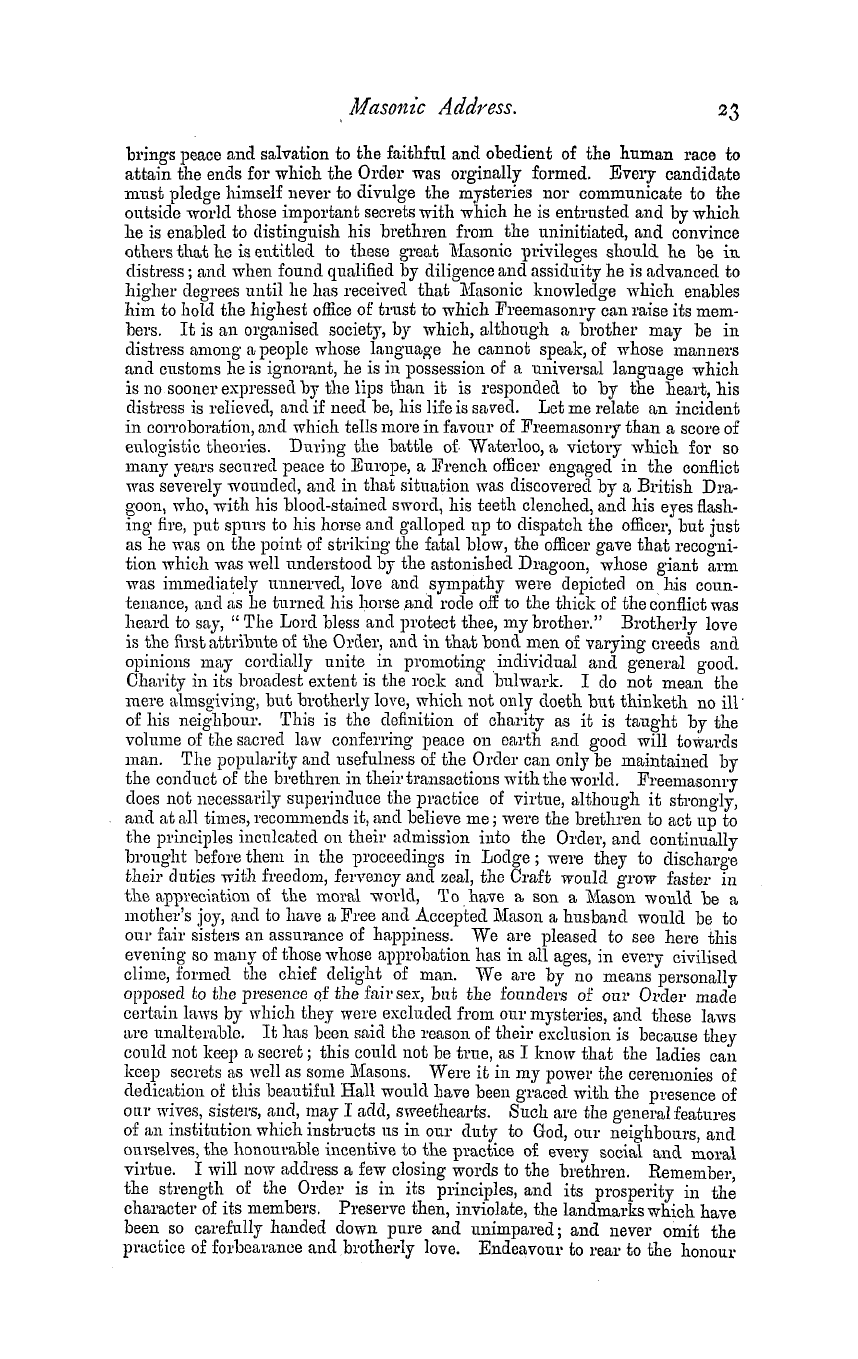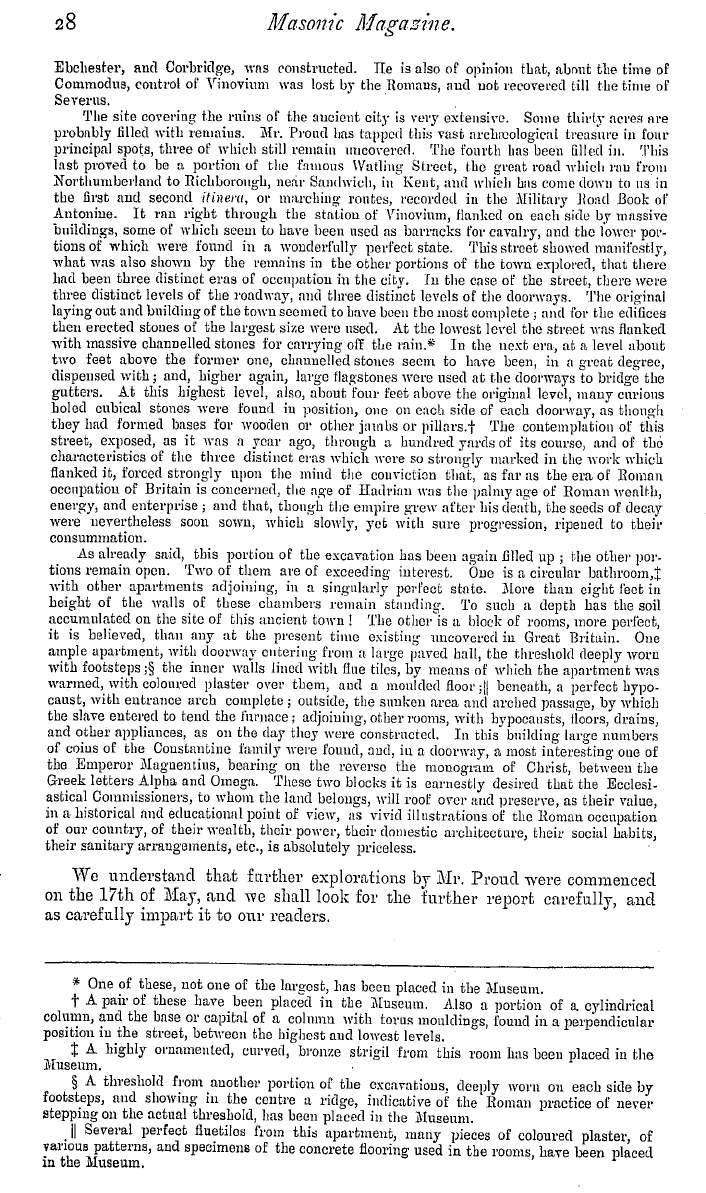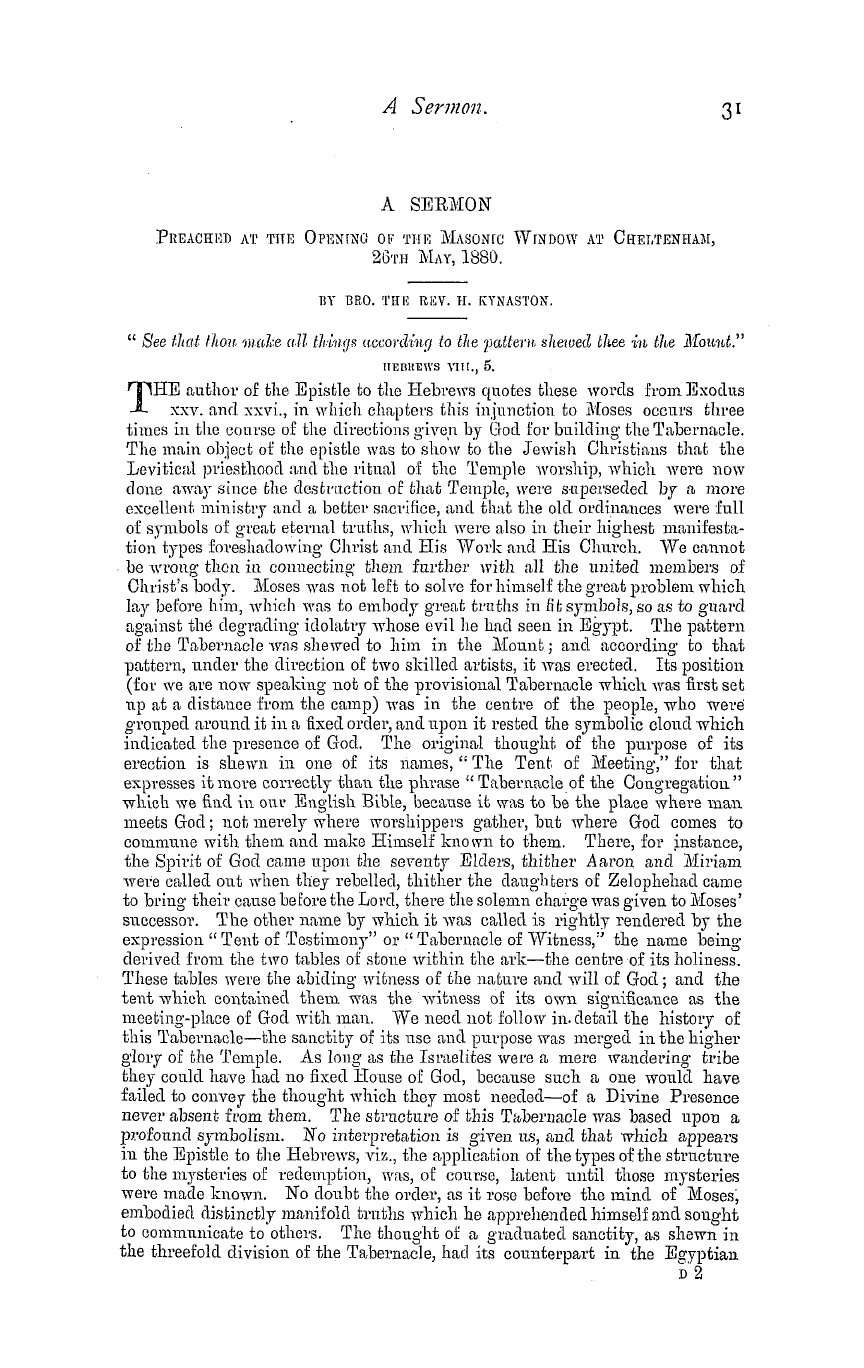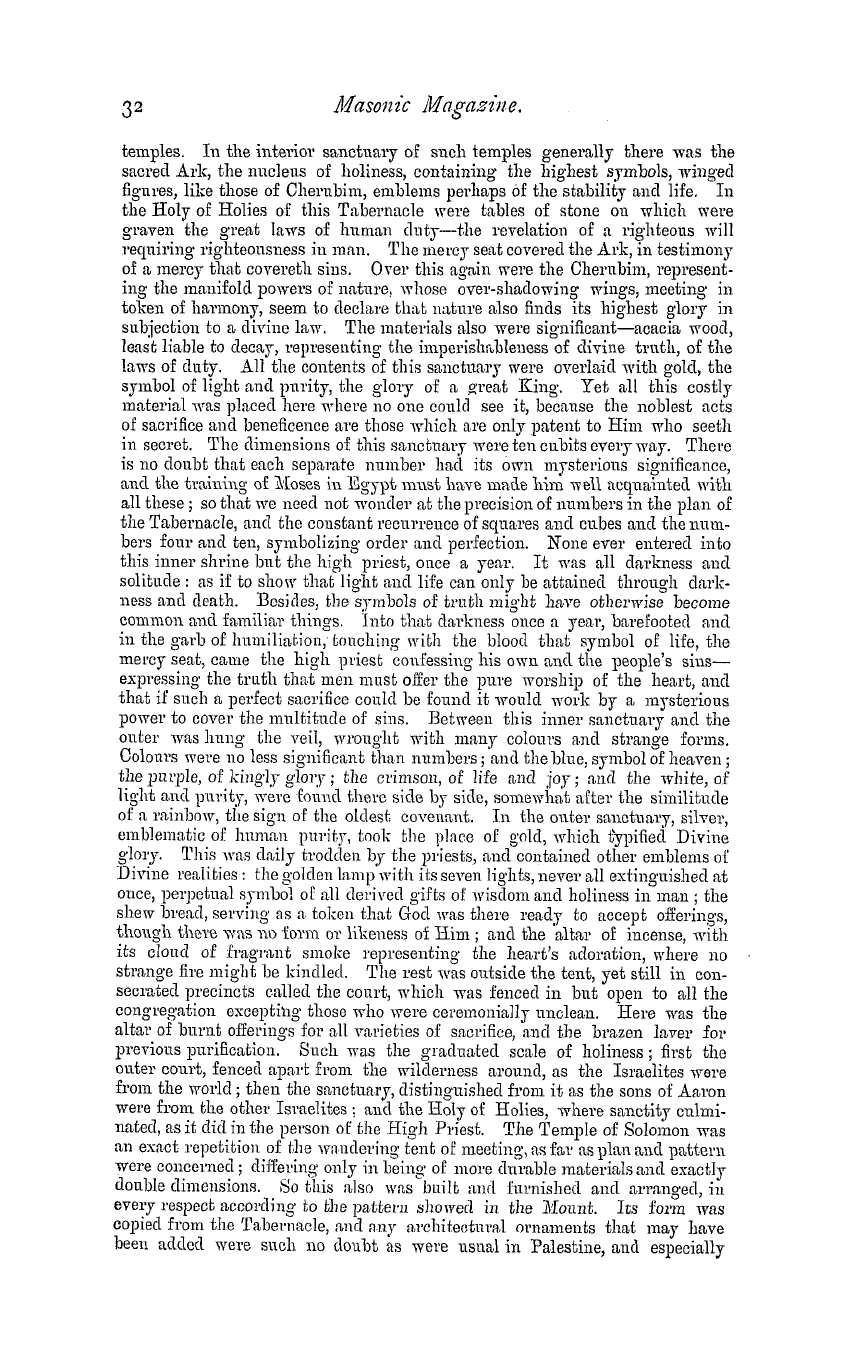Note: This text has been automatically extracted via Optical Character Recognition (OCR) software.
A Sermon
A SERMON
PREACHED AT TTTE OPENING OF THE MASONIC WINDOW AT CHELTENHAM . 26 TH MAY , 1880 .
BY BRO . THE REV . H . KYNASTON . " See that thou make all things according to the fatlem shewed thee in the Mount " IIEBHEWS VII ! ., 5 . THE author of the Epistle to the Hebrews quotes these words from Exodus xxv . ancl xxvi ., in which chapters this injunction to Moses occurs three
times in the course of the directions given by God for building the Tabernacle . The main object of the epistle was to show to the Jewish Christians that the Levitical priesthood and the ritual of tho Temple worship , which were now clone aw ay since the destruction of that Temple , were superseded by a more excellent ministry and a better sacrifice , ancl that the old ordinances were full of symbols of great eternal truthswhich were also in their highest
manifesta-, tion types foreshadowing Christ and His Work and His Church . We cannot be wrong then in connecting them further with all the united members of Christ ' s body . Moses was not left to solve for himself the great problem which lay before him , which was to embody great truths in fit symbols , so as to guard against the degrading idolatry whose evil he had seen in Egypt . The pattern of the Tabernacle was shewed to him in the Mount ; and according to that
pattern , under the direction of two skilled artists , it was erected . Its position ( for we are now speaking not of the provisional Tabernacle which was first set up at a distance from the camp ) was in the centre of the people , who were ' grouped around it in a fixed order , ancl upon it rested the symbolic cloud which indicated the presence of God . The original thought of the purpose of its erection is shewn in one of its names , " The Tent of Meeting , " for that
expresses it more correctly than the phrase "Tabernacle of the Congregation " which we find in our English Bible , because it was to be the place where man meets God ; not merely where worshippers gather , but where God comes to commune with them and make Himself known to them . There , for instance , the Spirit of God came upon the seventy Elders , thither Aaron and Miriam were called out when they rebelledthither the daughters of Zelophehad came
, to bring their cause before the Lord , there the solemn charge was given to Moses ' successor . The other name by which it was called is rightly rendered by the expression " Tent of Testimony" or " Tabernacle of Witness , " the name being derived from the two tables of stone within the ark—the centre of its holiness .
These tables were the abiding witness of the nature ancl will of Gocl ; ancl the tent which contained them was the witness of its own significance as the meeting-place of Gocl with man . We need not follow in . detail the history of this Tabernacle—the sanctity of its use and purpose was merged in the higher glory of the Temple . As long as the Israelites were a mere wandering tribe they could have had no fixed House of Gocl , because such a one would have failed to convey the thought wdiich they most needed—of a Divine Presence
never absent from them . The structure of this Tabernacle was based upon a profound symbolism . No interpretation is given us , ancl that which ap ]? ears in the Epistle to the Hebrews , viz ., the application of the types of the structure to the mysteries of redemption , was , of course , latent until those mysteries were made known . No doubt the order , as it rose before the mind of Moses , embodied distinctly manifold truths which he apprehended himself and sought to communicate to others . The thought of a graduated sanctity , as shewn in the threefold division of the Tabernacle , had its counterpart in the Egyptian D 2
Note: This text has been automatically extracted via Optical Character Recognition (OCR) software.
A Sermon
A SERMON
PREACHED AT TTTE OPENING OF THE MASONIC WINDOW AT CHELTENHAM . 26 TH MAY , 1880 .
BY BRO . THE REV . H . KYNASTON . " See that thou make all things according to the fatlem shewed thee in the Mount " IIEBHEWS VII ! ., 5 . THE author of the Epistle to the Hebrews quotes these words from Exodus xxv . ancl xxvi ., in which chapters this injunction to Moses occurs three
times in the course of the directions given by God for building the Tabernacle . The main object of the epistle was to show to the Jewish Christians that the Levitical priesthood and the ritual of tho Temple worship , which were now clone aw ay since the destruction of that Temple , were superseded by a more excellent ministry and a better sacrifice , ancl that the old ordinances were full of symbols of great eternal truthswhich were also in their highest
manifesta-, tion types foreshadowing Christ and His Work and His Church . We cannot be wrong then in connecting them further with all the united members of Christ ' s body . Moses was not left to solve for himself the great problem which lay before him , which was to embody great truths in fit symbols , so as to guard against the degrading idolatry whose evil he had seen in Egypt . The pattern of the Tabernacle was shewed to him in the Mount ; and according to that
pattern , under the direction of two skilled artists , it was erected . Its position ( for we are now speaking not of the provisional Tabernacle which was first set up at a distance from the camp ) was in the centre of the people , who were ' grouped around it in a fixed order , ancl upon it rested the symbolic cloud which indicated the presence of God . The original thought of the purpose of its erection is shewn in one of its names , " The Tent of Meeting , " for that
expresses it more correctly than the phrase "Tabernacle of the Congregation " which we find in our English Bible , because it was to be the place where man meets God ; not merely where worshippers gather , but where God comes to commune with them and make Himself known to them . There , for instance , the Spirit of God came upon the seventy Elders , thither Aaron and Miriam were called out when they rebelledthither the daughters of Zelophehad came
, to bring their cause before the Lord , there the solemn charge was given to Moses ' successor . The other name by which it was called is rightly rendered by the expression " Tent of Testimony" or " Tabernacle of Witness , " the name being derived from the two tables of stone within the ark—the centre of its holiness .
These tables were the abiding witness of the nature ancl will of Gocl ; ancl the tent which contained them was the witness of its own significance as the meeting-place of Gocl with man . We need not follow in . detail the history of this Tabernacle—the sanctity of its use and purpose was merged in the higher glory of the Temple . As long as the Israelites were a mere wandering tribe they could have had no fixed House of Gocl , because such a one would have failed to convey the thought wdiich they most needed—of a Divine Presence
never absent from them . The structure of this Tabernacle was based upon a profound symbolism . No interpretation is given us , ancl that which ap ]? ears in the Epistle to the Hebrews , viz ., the application of the types of the structure to the mysteries of redemption , was , of course , latent until those mysteries were made known . No doubt the order , as it rose before the mind of Moses , embodied distinctly manifold truths which he apprehended himself and sought to communicate to others . The thought of a graduated sanctity , as shewn in the threefold division of the Tabernacle , had its counterpart in the Egyptian D 2
















































